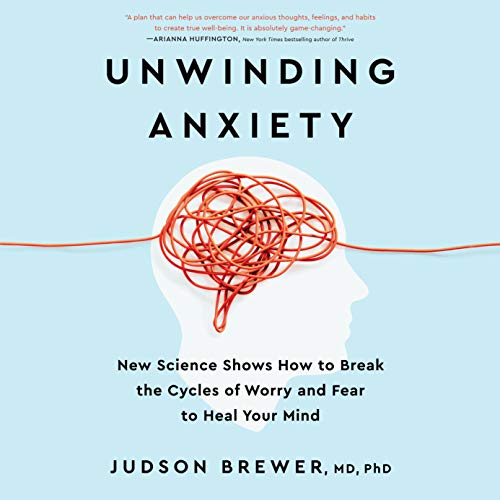
Unwinding Anxiety: New Science Shows How to Break the Cycles of Worry and Fear to Heal Your Mind by Judson Brewer offers actionable advice for anyone who suffers from anxiety. There is also a free app available that can further help make your life less stressful. Learn how you can use curiosity and kindness to your advantage. While I don’t suffer from anxiety, I know many people who do. If you are anxious, you need this book. It also makes a great gift for anxious friends and family. Thanks, Jud.
Introduction
- Judson has MD and PhD degrees which took eight years to complete. He then went on to a career as a psychiatrist doing research on anxiety. He found that anxiety is in and of itself a harmful habit. It hides in peoples’ bad habits and feeds other behaviors. When he realized this, due in part to his own panic attacks as a student, he was determined to “science the hell out of it,” to cite a Matt Damon quote from The Martian. During the last decade, his research has lead to excellent results in helping people quit smoking, overeating, and other bad habits with the help of smartphone apps. This book is intended to be a useful pragmatic guide to changing how you understand anxiety so that you can work with it effectively, and as a bonus, break your unhelpful habits and addictions.
Part 0 Understanding Your Mind: The Psychology and Neuroscience of Anxiety
1. Anxiety Goes Viral
- Anxiety is a feeling of worry, nervousness, or unease, typically about an imminent event or something with an uncertain outcome. Generalized Anxiety Disorder (GAD) is experienced by people who generally worry throughout the day. This usually results in poor sleeping habits. Other symptoms include edginess, restlessness, tiring easily, impaired concentration, irritability, and increased muscle aches. Specific phobias and obsessive-compulsive disorder also fall under anxiety diagnoses.
- Anxious parents are likely to have anxious kids. Uncertainty and lack of structure cause anxiety for many. It is tricky to diagnose as most people experience it to some degree. Worries about health, safety, finances, politics, and relationships are the top sources. COVID-19 has certainly added to our collective stress. People with GAD usually also suffer from depression or something else.
2. The Birth of Anxiety
- Anxiety and its close cousin panic are both born from fear. Ironically, fear’s main evolutionary function is helping us survive. Being afraid of dangerous situations and doing something about it is a good thing. The pre-frontal cortex (PFC) portion of our brain is where future scenarios get played out. It thinks slower than the reflexive part of our brain. When it doesn’t have enough information to predict the future it may start working on worst-case scenarios causing anxiety.
- Fear is an adaptive learning mechanism. Anxiety is maladaptive. Fear + Uncertainly = Anxiety. Without past experience or accurate information, it’s easy to turn on the worry switch. This is why fake news, which travels faster than real news, promotes anxiety. Our news media is more likely to give us stories that feed our anxiety than those that make us feel good. (Doug: If the news you watch makes you anxious, consider not watching it.) Anxiety is also contagious. Knowing this and that uncertainty triggers anxiety can help put you more at ease. It is possible to replace old habits like worry with habits that are more rewarding so stay tuned.
3. Habits and Everyday Addictions
- Most of us are addicted to something as addictions are not limited to things like hard drugs, alcohol, and tobacco. Compulsive behaviors like shopping and overeating also fall into this category. Our modern world has increased the likelihood of addictive habits as just about anything is much more available. The goal of the media is to increase clicks and eyeballs. Therefore they design not to inform, but to create addictive experiences. This starts with a Trigger, which is a thought or emotion. Next comes a Behavior like worrying. Finally, we have a Result or Reward such as avoidance or overplanning. Reinforcements and immediate availability are a dangerous formula for modern-day habits and addictions. This is how our brains work and this is important knowledge.
4. Anxiety as a Habit Loop
- Anxiety can act as a trigger that leads to the behavior of worrying. The result of this behavior can be feeling more anxious. That is the loop or cycle. While worrying usually doesn’t work, this doesn’t stop our brain from trying it again and again. Being aware of this is a good place to start. Judson and his team developed an app (Unwinding Anxiety) that they use to teach mindfulness to the subjects of their research. You can get a free trial or pay for the complete program. They used this app on doctors who do not get training on how to handle their emotions in medical school and found success with 63% of their subjects. First, you need to map out your anxiety. Then you tap into your brain’s reward system before you tap into your own neural capacities to step away from anxiety-producing habits.
DrDougGreen.com If you like the summary, buy the book





